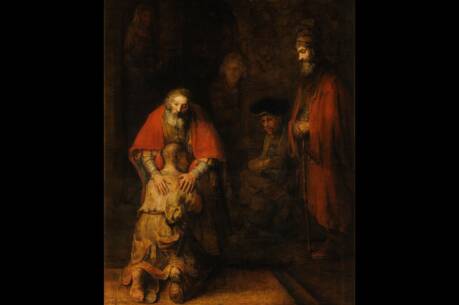Beyond Preaching Guilt: The Model of the Good Shepherd
Many of us carry vivid childhood memories of the big liturgies of Holy Week and Easter. In my own case, I often remember the long passion narrative that is read in parts on Palm Sunday and Good Friday. Missals in the pews divided the Gospel passage into four parts: narrator; Jesus; voice; and crowd. I remember even as a child waiting with anticipation to participate, not understanding more than that we were reenacting some sort of drama. The crowd’s line, “Crucify him! Crucify him!” left me with the impression that somehow the good people of my parish community were implicated in the death of Jesus. That was a lot to process as a child and it still perplexes me today. This Sunday’s readings balance that perspective with Jesus’ own understanding of his fundamental choice to “lay down his life” (Jn 10:11).
I am the good shepherd. A good shepherd lays down his life for the sheep. (Jn 10:11)
Who is a model disciple today that influences your journey of faith?
Where are you being called to lean into a courageous discipleship?
Are you able to lay down your life for others, following the model shepherd?
On the Fourth Sunday of Easter, the first reading continues with speeches from the Acts of the Apostles that articulate early Christian belief. Peter’s speech is meant to introduce the person of the risen Jesus to those who have never heard the good news or seen the healing power that the apostles displayed. Filled with the Holy Spirit, Peter explains, “It was in the name of Jesus Christ the Nazorean whom you crucified, whom God raised from the dead” (Acts 4:10). Peter identifies Jesus as “the stone rejected by you,” which reflects the sentiment of today’s psalm, “The stone the builders rejected has become the cornerstone” (Ps 118:22). The proverb of the cornerstone in the New Testament is meant to refer to Jesus’ death and resurrection as one reality not to be thought of separately. The cornerstone is that thing deemed insignificant by humans and elevated by God.
On the previous Sunday, Peter’s speech used similar language to remind an unsuspecting audience of their complicity in the savior’s death. “The author of life you put to death, but God raised him from the dead; of this we are witnesses” (Acts 3:15). Did the Sanhedrin then - and people today - know that the “author of life” was put to death? Probably not, but evil does not require awareness to inflict harm. Peter’s emphasis on human culpability for the death of Jesus might be true theologically, but this Sunday’s Gospel highlights Jesus’ own free choice. It also serves as a meaningful balance to Peter’s theology.
In today’s reading from the Gospel of John, Jesus is keenly aware of his Father’s mission which comes at a total cost of his life. This awareness and cost are foundational to the fourth Gospel. “This is why the Father loves me, because I lay down my life… No one takes it from me, but I lay it down on my own” (Jn 10:17-18). Notice the contrast from the first reading, which reminds us of our complicity in the death of Christ. In John’s meditation, by contrast, Jesus blames no one, since he has the power to lay down his life and to take it up again. This concluding sentiment follows a meditation on Jesus’ self-revelation as the “good shepherd” that is repeated twice in today’s passage. “I am the good shepherd… and I will lay down my life for the sheep” (Jn 10:11, 14). “Good” is used here in the classical Greek sentiment of unquestionable excellence and a model of blameless action. Jesus, as a “model shepherd,” illustrates his freedom to lay down his life. This is the model that is worthy of the title “good shepherd.”
This Sunday’s reading continues the week-by-week Easter meditation that helps us gradually recognize the risen Christ in our daily lives. Peter’s speeches in Acts remind us that sin is part of the human condition. As a citizen, for example, of a powerful nation, I know that I bear some responsibility for world peace and culpability for the wars my country does not work to halt. The Gospel, however, reminds us that although Jesus dies because of sin, he blames no one for his own death. His emphasis is focused on the mission given to him from the Father, a mission that required his total life. Jesus responded without hesitation. May we embrace this same mission encouraged by Jesus’ model of courageous discipleship, one that Pope Francis repeatedly articulates. It is the only kind of discipleship needed today to spread the good news of the good shepherd.








